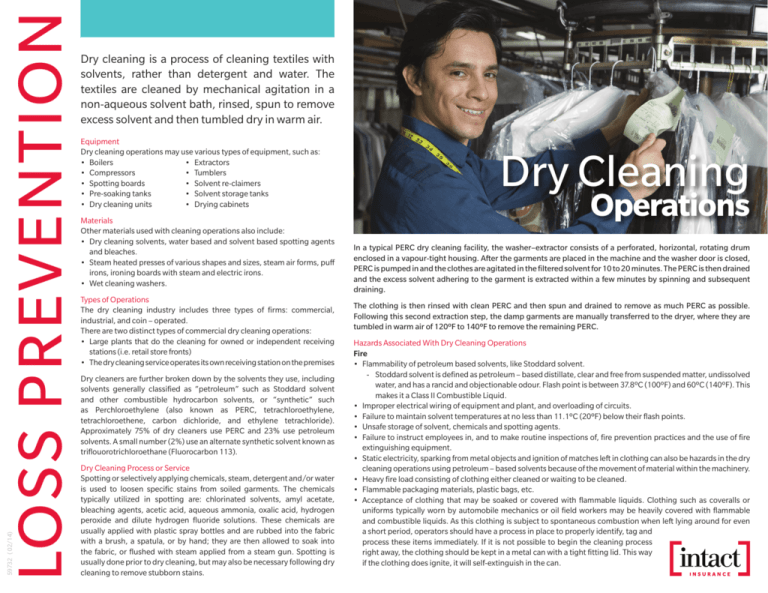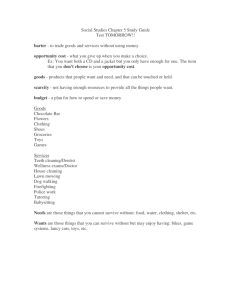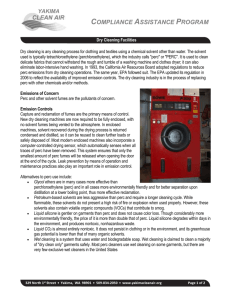
LOSS PREVENTION
59732 ( 02/14)
Dry cleaning is a process of cleaning textiles with
solvents, rather than detergent and water. The
textiles are cleaned by mechanical agitation in a
non-aqueous solvent bath, rinsed, spun to remove
excess solvent and then tumbled dry in warm air.
Equipment
Dry cleaning operations may use various types of equipment, such as:
• Boilers
• Extractors
• Compressors
• Tumblers
• Spotting boards
• Solvent re-claimers
• Pre-soaking tanks
• Solvent storage tanks
• Dry cleaning units
• Drying cabinets
Materials
Other materials used with cleaning operations also include:
• Dry cleaning solvents, water based and solvent based spotting agents
and bleaches.
• Steam heated presses of various shapes and sizes, steam air forms, puff
irons, ironing boards with steam and electric irons.
• Wet cleaning washers.
Types of Operations
The dry cleaning industry includes three types of firms: commercial,
industrial, and coin – operated.
There are two distinct types of commercial dry cleaning operations:
• Large plants that do the cleaning for owned or independent receiving
stations (i.e. retail store fronts)
• The dry cleaning service operates its own receiving station on the premises
Dry cleaners are further broken down by the solvents they use, including
solvents generally classified as “petroleum” such as Stoddard solvent
and other combustible hydrocarbon solvents, or “synthetic” such
as Perchloroethylene (also known as PERC, tetrachloroethylene,
tetrachloroethene, carbon dichloride, and ethylene tetrachloride).
Approximately 75% of dry cleaners use PERC and 23% use petroleum
solvents. A small number (2%) use an alternate synthetic solvent known as
triflouorotrichloroethane (Fluorocarbon 113).
Dry Cleaning Process or Service
Spotting or selectively applying chemicals, steam, detergent and/or water
is used to loosen specific stains from soiled garments. The chemicals
typically utilized in spotting are: chlorinated solvents, amyl acetate,
bleaching agents, acetic acid, aqueous ammonia, oxalic acid, hydrogen
peroxide and dilute hydrogen fluoride solutions. These chemicals are
usually applied with plastic spray bottles and are rubbed into the fabric
with a brush, a spatula, or by hand; they are then allowed to soak into
the fabric, or flushed with steam applied from a steam gun. Spotting is
usually done prior to dry cleaning, but may also be necessary following dry
cleaning to remove stubborn stains.
Dry Cleaning
Operations
In a typical PERC dry cleaning facility, the washer–extractor consists of a perforated, horizontal, rotating drum
enclosed in a vapour-tight housing. After the garments are placed in the machine and the washer door is closed,
PERC is pumped in and the clothes are agitated in the filtered solvent for 10 to 20 minutes. The PERC is then drained
and the excess solvent adhering to the garment is extracted within a few minutes by spinning and subsequent
draining.
The clothing is then rinsed with clean PERC and then spun and drained to remove as much PERC as possible.
Following this second extraction step, the damp garments are manually transferred to the dryer, where they are
tumbled in warm air of 120ºF to 140ºF to remove the remaining PERC.
Hazards Associated With Dry Cleaning Operations
Fire
• Flammability of petroleum based solvents, like Stoddard solvent.
-- Stoddard solvent is defined as petroleum – based distillate, clear and free from suspended matter, undissolved
water, and has a rancid and objectionable odour. Flash point is between 37.8ºC (100ºF) and 60ºC (140ºF). This
makes it a Class II Combustible Liquid.
• Improper electrical wiring of equipment and plant, and overloading of circuits.
• Failure to maintain solvent temperatures at no less than 11.1ºC (20ºF) below their flash points.
• Unsafe storage of solvent, chemicals and spotting agents.
• Failure to instruct employees in, and to make routine inspections of, fire prevention practices and the use of fire
extinguishing equipment.
• Static electricity, sparking from metal objects and ignition of matches left in clothing can also be hazards in the dry
cleaning operations using petroleum – based solvents because of the movement of material within the machinery.
• Heavy fire load consisting of clothing either cleaned or waiting to be cleaned.
• Flammable packaging materials, plastic bags, etc.
• Acceptance of clothing that may be soaked or covered with flammable liquids. Clothing such as coveralls or
uniforms typically worn by automobile mechanics or oil field workers may be heavily covered with flammable
and combustible liquids. As this clothing is subject to spontaneous combustion when left lying around for even
a short period, operators should have a process in place to properly identify, tag and
process these items immediately. If it is not possible to begin the cleaning process
right away, the clothing should be kept in a metal can with a tight fitting lid. This way
if the clothing does ignite, it will self-extinguish in the can.
Toxicity
• Toxicity of chlorinated synthetic solvents, such as PERC.
-- Although it is a non-flammable liquid, it does give off toxic
vapours at normal temperatures and, if exposed to excessive
heat such as that produced by open flames, hot surfaces, etc.,
breaks down to form phosgene and other poisonous gases and
corrosive gases.
úú Phosgene was used as a chemical weapon in Word War
one. It is colourless, but can appear as a white or yellowish
haze when released into the air due to refraction of light.
In low concentrations, its odour resembles recently cut
hay.
Other
• Poor housekeeping, lint, and trash accumulation and a lack of
general cleanliness.
• Failure to properly operate and maintain equipment, especially
steam boilers, compressors, tumblers and finishing equipment.
Safeguards Necessary to Control the Hazards
The class of solvent used governs the location and design, the
ventilation, electrical and equipment requirements, the fire control
measures required, and the construction of a dry cleaning plant.
The U.S. National Fire Protection Agency (NFPA) has established
categories based on the flammability of the solvent used in their
Standard for Dry Cleaning Plants (NFPA 32). These are:
Type I
Systems using solvents with a flash point less than
37.8ºC such as naptha (f.p. 10ºC). These systems are
now prohibited by the “Standard for Dry Cleaning
Plants”.
Type II
Systems using solvents with a flash point at or above
37.8ºC but below 60ºC.
Type III
Systems using solvents with a flash point at or above
60ºC but below 93.4ºC.
Type IV
Systems using solvents with a flash point at or above
93.4ºC.
Type V
Systems using non flammable solvents with cleaning
equipment not operated by the general public.
As Type I is prohibited, the remainder of these safeguards pertain to
the second most hazardous type of operation from a fire protection
standpoint, the Type II operation. For additional information on Type
II and the remaining four types, please refer to the following sources:
• NFPA 32 – Standard for Dry Cleaning Plants.
• NFPA 90A and 91 – Ventilation and Electrical Equipment.
• NFPA 30 – Flammable & Combustible Liquids Code.
CHECKLIST FOR DRY CLEANERS USING PERC
Type II Dry Cleaning Plants
Location and construction
• Dry cleaning operations shall not be performed in the same
building with other occupancies.
• The building shall be accessible from at least one side for fire
fighting and shall not be closer than 3.1m (10 feet); to the adjoining
property line. Walls must be non-combustible (at least).
• Dry cleaning and tank storage rooms shall not be located below
grade or above any other storey.
• The dry cleaning room shall be separated from other related
operations by at least two hour fire partitions.
• Dry cleaning rooms must have at least two doors as a means of
exiting; they must be located at the opposite ends of the room, at
least one of which leads directly outside.
• Electrical equipment and wiring shall be designed for Class I,
Division 2 locations.
üNo
ü spotting agent that contains PERC.
Storage tanks
• Solvent storage tanks must be installed and constructed as
outlined in NFPA 30, Flammable and Combustible Liquids Code.
• Solvent storage tanks shall be underground or outside above
ground, except up to two tanks with a maximum capacity of 5,678
litres may be located inside a dry cleaning room.
Fire Protection
• A building housing a dry cleaning room must be completely
protected by a sprinkler system.
• At least two 10BC portable fire extinguishers are required near the
doors in a dry cleaning room.
For Full Information
Due to environmental and health risk concerns, the Government of
Canada has developed regulations pertaining to the use and handling
of PERC. For additional information, Environment Canada has
the complete Compliance Guide for Dry Cleaners available on its
web site.
For more information, please visit www.intactprevention.com
Type VI
Systems using non flammable solvents with cleaning
equipment being operated by the general public.
Most commonly these would be coin-operated
machines.
This document is for informational purposes only and should not be construed as
being advice or exhaustive. Intact Insurance makes no representation, warranty
or guarantee that use of this information will prevent damage or reduce your
premium. Your insurance contract prevails at all times, please consult it for a
complete description of coverage and exclusions. Certain conditions, restrictions
and exclusions apply. ®Intact Insurance Design is a registered trademark of Intact
Financial Corporation used under license. ©2013 Intact Insurance Company. All
rights reserved.
Dry Cleaning Facility
üPERC,
ü
waste water, and residue stored in closed
containers.
üPERC
ü
resistant floor drain plugs are readily
available.
üContainers,
ü
tanks, or dry cleaning machines
containing PERC, waste water, or residue are
stored within a secondary containment system.
Dry Cleaning Machines
üNo
ü transfer machine or self-service machine.
üMust
ü
be equipped with an integral refrigerated
condenser and an integral PERC water separator.
üNo
ü vent to the atmosphere during the washing,
extraction, drying and aeration cycles.
üNo
ü carbon absorbers as the primary vapour control
device.
üMust
ü
be a closed direct-coupled delivery system
for PERC delivery.
üThe
ü
manufacturer’s design rating for PERC
consumption is equal to or less than 6.2 L (or
10 kg) PERC/100 kg of clothing cleaned (for
machines installed after July 31, 2003).
Secondary Containment System
üImpermeable
ü
to PERC.
üEncompasses
ü
at least the entire surface under each
dry cleaning machine, tank, or other containers
containing PERC, waste water, or residue.
üCapable
ü
of containing at least 110% of the
capacity of the largest tank or container within the
containment system.










